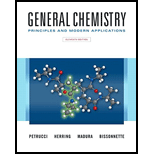
Concept explainers
Interpretation:
The structure of the isomers that would expect to obtain in the mononitration of
Concept introduction:
The electrophilic
Nitration of benzene is an example of electrophilic aromatic substitution.
The activating groups are the groups that have the ability to donate the electron density to the benzene ring. The deactivating groups are the groups that have the ability to withdraw the electron density to the benzene ring.
The ortho and para directing groups are the activating groups while meta direction groups are deactivating groups.
Want to see the full answer?
Check out a sample textbook solution
Chapter 27 Solutions
Generl Chem Looself&mod Mst/et&stdy Crd Pkg, 11/e
- Give the structures of the substitution products expected when 1-bromohexane reacts with(a) NaOCH2CHarrow_forwardBromine reacts with alkenes in methanol according to the equation when this reaction was carried out with 4-tert-butylcyclohexene, only one isomer was formed with the molecular formula C12H23BrO (80% yield). Which of the following is the structure more reasonable for this compound? Explain your reasoning through a corresponding mechanism.arrow_forwardWhat are the three alkenes formed in the acid-catalyzed dehydration of 2-pentanol? Propose the mechanism of their formation.arrow_forward
- 3. The reaction of bromine with 3-hexanone produces two isomeric products of formula C6H11BrO. Give the mechanism for obtaining the two isomers.arrow_forwardDescribe the product formed as a result of the reaction between cyclohexanone and 3-butene-2-one by also writing the mechanism of the reaction.arrow_forwardPredict the mononitration products of the following aromatic compounds. m-nitrochlorobenzenearrow_forward
- What is the major monosubstitution product from the Friedel—Crafts reaction of benzene with 1 -chloro-2-methylpropane in the presence of AlCl3?arrow_forward4. Heptyl phenyl ketone was formed from the Friedel-Crafts acylation of benzene with an acyl chloride. What is the IUPAC name of the original acyl chloride? 5. How many isomers are there Of C6H14? 6. Aside from a halogenated alkane, what other product results from the bromination of hexane? Write the formulaarrow_forwardHydroboration-oxidation of 2-pentyne gives a mixture of two ketones, each with the molecular formula C5H10O. Propose structural formulas of these two ketones. Explain your proposal.arrow_forward
- Compound A, C 10H 18O, undergoes reaction with dilute H 2SO 4 at 50 °C to yield a mixture of two alkenes, C 10H 16. The major alkene B, gives only cyclopentanone after ozone treatment followed by reduction with zinc in acetic acid. Which of the following reactions are correct. Can be more than one answerarrow_forwardBromine reacts with alkenes in methanol according to the equation (see image 1). When this reaction was carried out with 4-tert-butylcyclohexene, only one isomer was formed with the molecular formula C12H23BrO (80% yield) a) Which of the following is the structure more reasonable for this compound? (see image 2) b) Explain your reasoning through a corresponding mechanismarrow_forwardYou are required to synthesize 2-bromopentane from the reaction between an alkene with HBr. Which alkene, 1-pentene or 2-pentene, should you react with HBr in order to get 2-bromopentane? Give an explanation.arrow_forward
 Macroscale and Microscale Organic ExperimentsChemistryISBN:9781305577190Author:Kenneth L. Williamson, Katherine M. MastersPublisher:Brooks Cole
Macroscale and Microscale Organic ExperimentsChemistryISBN:9781305577190Author:Kenneth L. Williamson, Katherine M. MastersPublisher:Brooks Cole

